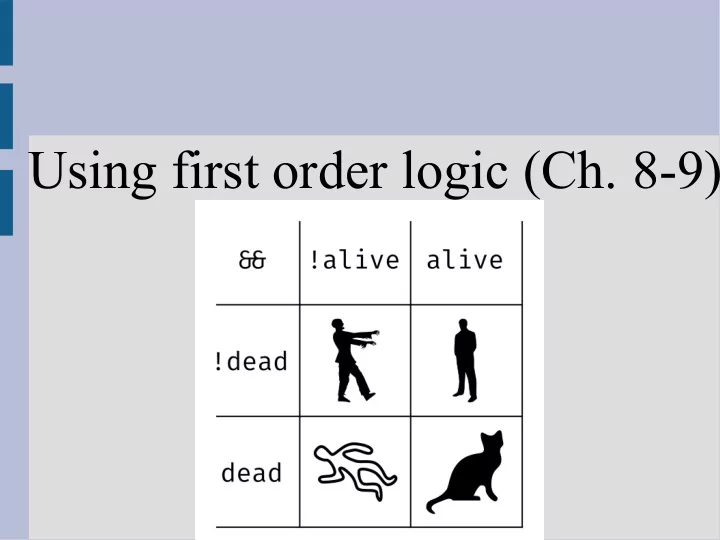

Using first order logic (Ch. 8-9)
Review: First order logic In first order logic, we have objects and relations between objects The relations are basically a list of all valid tuples that satisfy the relation We can also have variables that represent objects often used in conjunction with quantifiers:
First order logic Let's translate English into first order logic: “Everyone in class is sitting in a seat” “If someone is sitting in a seat it is occupied” “At least one seat is not occupied” “No one is sharing a seat” Objects: People (p1, p2, ...), Chairs (c1, c2, ...) Relations: InClass(x), InSeat(x,y), Occupied(x) Person(x), Chair(x) person chair
First order logic “Everyone in class is sitting in a seat” “If someone is sitting in a seat it is occupied” “At least one seat is not occupied” “No one is sharing a seat”
First order logic More practice? General guide: https://cs.nyu.edu/faculty/davise/ai/folguide.pdf Examples: http://www.uobabylon.edu.iq/eprints/publication_5_29514_1380.pdf https://math.stackexchange.com/questions/2209569/how-to-translate-the-following-sentences-into-first-order-logic
First order logic To express the top left cell for mindsweep in propositional logic, we had to write: How would you write the whole current knowledge for all 5 cells in first order logic? (not the game logic, just current state) Hint: What are objects? Relations?
First order logic First order logic: Then we just also need to say that cells can only have one number/bomb
Using First order logic The rest of chapter 8 is boring, so we will skip (though good practice for logic representation) We will go ahead into Ch. 9 and talk about how to use first order logic with entailment First we will look at how we can simplify some of the quantifiers
Universal instantiation With a universal quantifier, , this means you can replace it with any object For example: Objects = {Sue, Bob, Devin} Sentence = You can conclude:
Existential instantiation With an existential quantifier, , there is some object that makes this true... So you give it a name of a new object (that is equal to an existing object) Objects = {Spider, Dragon, Pangolin} Sentence = You can conclude: where
Convert to propositional logic You can convert first order logic back into propositional logic by using instantiation Objects = {Tree, Car} Sentences: Instantiation:
Convert to propositional logic Once you have this, you can treat each relation/object as a single proposition uniquely identified by the characters ... could turn into: ... and we could use our old techniques to ask information
Convert to propositional logic This explanation glosses over two important facts... what?
Convert to propositional logic This explanation glosses over two important facts... what? 1. Equals 2. Functions (1) is easier to tackle as you can remove this when doing instantiation/enumeration You simply remove the invalid statements
Remove equality Removing = after instantiation: Object={A,B} Sentence: Instantiation: Remove conflicts:
Converting functions I have skimmed on functions, but similar to math functions they can be applied repeatedly Define: PlusPlus(x): PlusPlus(1) = 2 PlusPlus(PlusPlus(1)) = 3 ... and so on (no limit to number of functions) When converting to prop. logic, you have to apply functions everywhere possible...
Converting functions This means the propositional logic conversion might have an infinite number of propositions A theorem shows you only need a finite number of function calls to decide entailment Step 1: See if entailed with no functions Step 2: See if entailed with 1 function call Step 3: See if entailed with 2 function calls Step 4: ...
Converting functions At some finite step, if entailment is possible it will be found Unfortunately, how many is unknown so it is impossible to find if something is not entailed in the propositional logic (this is semi-decidable) Even without functions if there are p k-ary relations with n objects, you get: O(p*n k )
Unification A unification is a substitution for variables that creates a valid sentence by specifying a map between variables and objects For example, consider: What variables can we unify/substitute?
Unification First sentence is the only one with variables, there are 9 options (only 6 if x ≠ y) One unification is {x/Sue, y/Devin} We cannot say {x/Devin, y/Alex}, as this is creates a contradiction
General modus ponens We do not need to convert to propositional logic to use some rules of reasoning Modus ponens can be applied even if there are variables, as long as we can unify them: We can unify the top sentence with {x/Hippo}, so we can conclude:
General modus ponens If you want to use this general modus ponens, finding the unification can be expensive You basically need to try all substitutions, though you can store your data in smart ways to make look-up much more quickly Using just general modus ponens, you can do basic inference with first order logic (what is the problem??)
General modus ponens Objects = {Cat, Dog, Frog, Rat, Sally, Jane} Is Sally happy? How about Party(Sally, Frog)?
General modus ponens We can substitute {x/Sally} here with MP: To get: Then sub. {x/Sally, y/Frog} with MP here: To get: However, we cannot tell if Sally is happy, as we cannot unify:
Recommend
More recommend